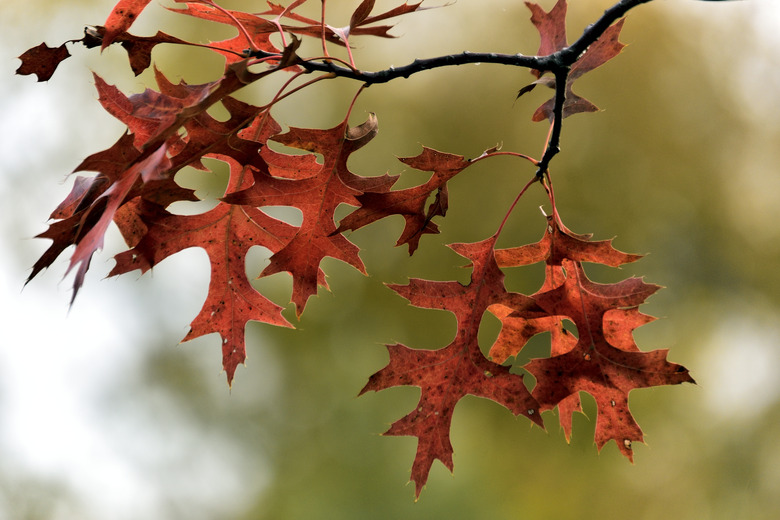Types Of Leaf Patterns
The foliage of hardwood trees and shrubs – members of the angiosperms, or flowering plants – provides some of the clearest and most conspicuous clues available to identifying species. And among the several general characteristics to key into are a leaf's veins: those bundles of vascular tissue – xylem and phloem – responsible for transporting nutrients, sugars and water, as well as providing a sort of skeletal support for these all-important organs of photosynthesis. Leaf vein patterns divide hardwood leaves – nearly all of which have net-like, or reticulate, venation – into a few basic categories.
Pinnate Leaf Veins
Pinnate
Leaf Veins
In pinnate, or feather, venation, a primary vein or midrib runs down the center of the leaf blade from the leafstalk (or petiole) toward the tip, and parallel secondary or lateral veins branch off from this, angled forward to varying degrees. This is the more common netted-vein pattern among hardwoods, found for example in oaks, elms, beeches, chestnuts, alders, birches and cherries. A variation of the pinnate pattern – sometimes separated into its own category – is arcuate venation, wherein the secondary veins curve significantly along the margins of the leaf – a form seen, for instance, in dogwoods.
Palmate Leaf Veins
Palmate
Leaf Veins
If pinnate veins resemble feathers, a palmately veined leaf looks something like an outstretched hand. This fingerlike pattern "stems" (if you will) from multiple primary veins spreading out from a common point at the base of the leaf blade. Maples serve as the classic example; sycamores or plane-trees, sweetgums and Europe's white poplar also grow palmately veined leaves.
Intermediate Form: Pinnipalmate
Intermediate
Form: Pinnipalmate
Certain classification schemes separate out some hardwoods with venation patterns blending pinnate and palmate characteristics. In the pinnipalmate arrangement, the lowest pair of secondary veins – the pair closest to the blade base, in other words – are thicker and more pronounced than higher ones, giving a sort of palmate look to the lower portion of the leaf in an overall pinnate scheme. Examples include the leaves of certain basswoods/lindens and the sugarberry, as well as certain vines such as wild grapes and the Carolina coralbead.
Venation Pattern vs. Compound Leaf Arrangement
Venation
Pattern vs. Compound Leaf Arrangement
One potential source of confusion is the use of the terms "pinnate" and "palmate" to describe both leaf venation as well as the configuration of compound leaves, which – unlike simple leaves with one leaf blade per leafstalk – sport multiple leaflets on a stalk. Compound leaves with paired leaflets running down the central stalk are pinnately compound, whereas those whose leaflets spread from a shared point on the stalk are palmately compound. In such common palmately compound leaves as hickories, buckeyes and horse-chestnuts, the leaflets themselves show pinnate venation.
Monocot Leaf Patterns
Monocot
Leaf Patterns
True hardwood trees and shrubs belong to one major family of flowering plants, the dicots. The other group, the monocots, includes grasses, sedges, rushes, a wide variety of forbs and a few tree-sized plants such as bananas, pandanus and palms (not to mention the giant grasses called bamboos, which may reach dozens of feet tall). Most monocots exhibit parallel leaf venation in which multiple veins run along the same axis from base to tip.
References
- University of Illinois: Botanical Terminology – Leaf Veins: Palmate
- The Sibley Guide to Trees; David Allen Sibley
Cite This Article
MLA
Shaw, Ethan. "Types Of Leaf Patterns" sciencing.com, https://www.sciencing.com/types-leaf-patterns-6699250/. 22 November 2019.
APA
Shaw, Ethan. (2019, November 22). Types Of Leaf Patterns. sciencing.com. Retrieved from https://www.sciencing.com/types-leaf-patterns-6699250/
Chicago
Shaw, Ethan. Types Of Leaf Patterns last modified March 24, 2022. https://www.sciencing.com/types-leaf-patterns-6699250/
